
Facebook Twitter Instagram YouTube
Written on: September 19th, 2017 in Wetland Animals
By Brittany Haywood, DNREC’s Wetland Monitoring and Assessment Program
Did you know that Delaware has multiple species of crayfish? While crayfish may look like small lobsters, they are actually distant cousins. The most differentiating feature is that lobsters live in saltwater, and crayfish, crawfish, crawdads, or whatever you would like to call them, live in fresh to brackish waters.
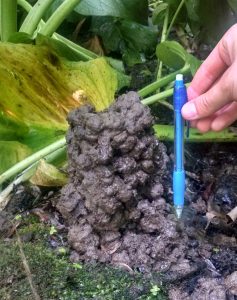
Some crayfish species living in Delaware are naturally occurring here (native), while some come from other parts of the country (invasive), and they all come in various colors and sizes. You are likely to find these crustaceans in flowing streams, lakes, swamps, ponds, and seasonally wet wetland habitats. They live their lives safely burrowed in underground tunnels or hiding out in open water, or some combination of the two. Fun fact, as long as the crayfish’s gills stay moist, it can breathe on land or in the water.
Crayfish are opportunistic feeders using the two antenna on the top of their head to seek out the chemicals that “smell” most tasty to them. They will chow down on decomposing plant or animal parts, slow moving macroinvertebrates such as snails, underwater grasses, amphibians, and fish eggs. Interestingly enough though, juvenile crayfish seem to prefer a diet consisting of mostly meat, while adult crayfish seem content munching away on plant materials.
On the other hand, crayfish also serve as a tasty treat to bass, snapping turtles, raccoons, and herons, and are used as bait by fisherman to catch fish.
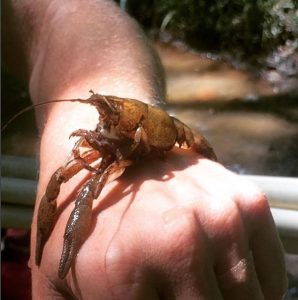
These hard-shelled critters also have interesting behaviors. To escape a predator, they will try to tail flip themselves away. Don’t think they are wimps though, because they aren’t afraid to get down and dirty. Fighting is commonplace among crayfish, whether it be over food, shelter, or selecting the perfect mate. They box, push, grasp, and grab at their opponent until one submits or loses a limb.
But, how does one crayfish know when the other has submitted? Crayfish have developed body language and chemical signals that let their opponent know when they’ve given up. If a crayfish lays its body flat against the ground with its claws forward, or if it does a tail flip and propels itself backwards, it has submitted and the battle is over.
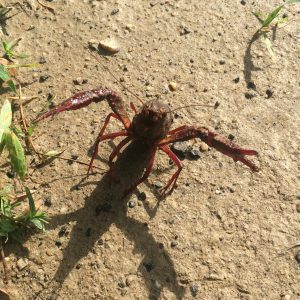
Crayfish behaviors can vary by species, especially when it comes down to aggression. For example, the red swamp crayfish (Procambarus clarkii) is known for its very aggressive behavior and delicious taste, and it just so happens to be an invasive species right here in Delaware. It uses its aggressive behavior to out-compete native species of crayfish and amphibians for shelter and food.
Native to the U.S.’s Gulf Coast, the red swamp crayfish made its way to Delaware through people releasing or disposing them as unwanted food, pets, or bait. One paper from Indiana hypothesized that flushing crayfish down the toilet was an inappropriate way to dispose of them because they were being found around waste water treatment facilities, “having apparently survived treatment.”
Long story short, crayfish are cool, but the invasive species are bad, and never flush unwanted animals—including crayfish– down the toilet because you never know where they might end up (or what they might turn into).
Red Swamp Crayfish Identification:
• Tolerates a range of salinities and pollution
• Can grow up to 5 inches long
• Dark red in color
• Raised bright red spots on claws and body
• Juveniles are not red and can be difficult to identify
• Have an approximate two year life span in the wild
• If you see one, please report it to the Delaware Division of Fish and Wildlife at 302-735-8655
Written on: September 19th, 2017 in Wetland Assessments
By Kari St.Laurent, DNREC’s Delaware National Estuarine Research Reserve
Wetlands are more than just a beautiful photo opportunity. If you are a reader of this blog, you are probably aware that tidal wetlands can protect shorelines from storm surge, reduce nutrients, and provide habitat for critters like shellfish, crabs, and fish. These benefits are collectively known as ecosystem services. Recently, there is another ecosystem service that has been gaining interest from wetland scientists, coastal resources managers, and policy-makers alike – the ability for tidal wetlands to trap and store carbon!
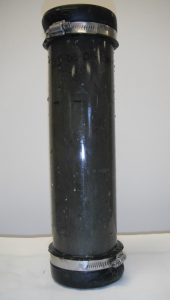
Tidal wetlands can store mass amounts of carbon within its thick layers of sediment. Plants, including Spartina alterinflora, take in atmospheric carbon dioxide during photosynthesis and turn it into part of their cellular structure. When these marsh plants die, that carbon can be buried into the marsh sediment where it can stay trapped as organic matter for millennia. Organic matter can also be deposited onto a marsh by tides and water coming off from land. This process of carbon going from the atmosphere into marsh plants and sediments is called carbon sequestration.
One key feature of a tidal marsh is its ability to accrete, or be able to vertically build-up sediment to keep pace with local sea level changes. As this layer of marsh sediment gets deeper and deeper, it becomes harder for this trapped carbon to get released back into the atmosphere. Thus, marshes can be a sink for carbon dioxide!
This storage of carbon within tidal wetland ecosystems has earned the name blue carbon. Impressively, tidal wetlands can store more carbon per area than a forest because of its deep layers of mud – measured as deep as 32 feet in Belize. And that carbon in a tidal wetland can be stored for 1000’s of years while systems like a rainforest store carbon for shorter periods, such as decades to centuries. This makes blue carbon an important component of the global carbon cycle.
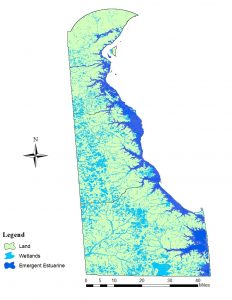
Healthy marshes will continue to trap and store carbon, in addition to providing valuable habitat, protection from storms, and natural filtration of nutrients. However, when marshes are lost or degraded, that carbon storage benefit is lost – and even more, that previously stored carbon can be released back into the environment. The protection and restoration of wetlands is a great way to help continue carbon sequestration and storage within tidal wetlands.
So just how much carbon is sequestered each year within Delaware’s approximately 73,000 acres of tidal wetlands? This past summer, DNREC-Delaware Coastal Programs hosted Bryce Stevenosky, a DENIN intern from the University of Delaware, to help us understand this question using published scientific literature. While this is just a back-of-the-envelope type of estimate, it starts to put the amount of blue carbon into perspective for Delaware’s wetland scientists.
Bryce estimated the amount of carbon sequestered each year into Delaware’s marsh sediments is 57,000 metric tons of carbon dioxide. To put this into perspective, the average car emits 4.7 metric tons of carbon each year. This means that Delaware’s wetlands sequester the emissions of over 12,000 cars each year. That’s greater than the population of Smyrna!
This estimate is just the beginning for Delaware’s coastal resources managers and scientists to understand the role wetlands play in storing carbon dioxide, and what we could stand to lose if wetlands are lost. More work needs to be done in Delaware to understand these complex processes and put a site-by-site specific value on just how much carbon Delaware’s tidal wetlands are trapping for us.